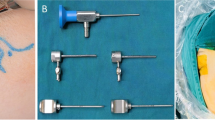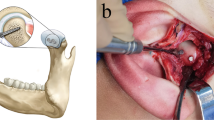Abstract
Introduction
Various surgical modalities have been tried for the correction of chronic recurrent dislocation of the temporomandibular joint. However, most of these techniques are aimed at creating an artificial block or removing any interference in the path of the translating condyle. Chronic dislocation can also be classified as meniscotemporal and menisocondylar, depending upon whether the dislocation occurs between the condyle–disc unit and temporal bone (meniscotemporal), or between the disc and condyle (meniscocondylar). Very few procedures address the primary issue of a malpositioned disc, which is the cause of meniscocondylar dislocation.
Materials and Methods
This study was conducted on 17 patients (27 joints) who reported with chronic dislocation of the temporomandibular joint, with MRI-proven meniscocondylar dislocation. After exposure of the condyle and disc through a standard pre-auricular incision, an orthodontic mini-screw was fixed to the posterior aspect of the condylar head and a 1-0 Prolene suture passed through the screw-head eyelet, plicating the posterior edge of the disc to the condyle. This ensured that the condyle and disc would move in unison.
Results
All the patients showed improvement in their symptoms of dislocation in the postoperative period, including seven patients in whom only a unilateral procedure was carried out. None of the patients had any recurrence till the 1-year followup.
Conclusion
Our procedure addresses the fundamental etiology of meniscocondylar dislocation by anchoring the disc to the condyle by using an orthodontic mini-implant and correcting the condyle–disc disharmony. This technique is reliable, technically feasible, and cost-effective in the Indian set up.












Similar content being viewed by others
References
Undt G, Kermer C, Piehslinger E, Rasse M (1997) Treatment of recurrent mandibular dislocation, Part I: Leclerc blocking procedure. Int J Oral Maxillofac Surg 26(2):92–97
Nitzan DW (2002) Temporomandibular joint “open lock” versus condylar dislocation: signs and symptoms, imaging, treatment, and pathogenesis. J Oral Maxillofac Surg 60(5):506–511; discussion 512-3
Gray AR, Barker GR (1991) Idiopathic blepharospasm-oromandibular dystonia syndrome (Meige’s syndrome) presenting as chronic temporomandibular joint dislocation. Br J Oral Maxillofac Surg 29(2):97–99
Shorey CW, Campbell H (2000) Dislocation of the temporomandibular joint. J Oral Surg Oral Med Oral Pathol Oral Radiol Endod 89(6):662–668
Torres DE, McCain JP (2012) Arthroscopic electrothermal capsulorrhaphy for the treatment of recurrent temporomandibular joint dislocation. Int J Oral Maxillofac Surg 41(6):681–689
Silver CM, Simon SD (1963) Operative treatment for recurrent dislocation of temporomandibular joint. Wiederherstellungschir Traumatol. 7:186–201
Dolwick MF, Sanders B (1985) TMJ internal derangement and arthrosis. Surgical Atlas. St. Louis (MO): Mosby; Chapter 5, Surgery; pp 139–196
Quinn P (1998) Color atlas of temporomandibular joint surgery. St. Louis (MO): Mosby; Chapter 4, Surgery for Internal Derangements; pp 55–99
Mehra P, Wolford LM (2001) The Mitek mini anchor for TMJ disc repositioning: surgical technique and results. Int J Oral Maxillofac Surg 30(6):497–503
Tachibana R, Motoyoshi M, Shinohara A, Shigeeda T, Shimizu N (2012) Safe placement techniques for self-drilling orthodontic mini-implants. Int J Oral Maxillofac Surg 41(11):1439–1444
Leopard PJ (1987) Surgery of the non-ankylosed temporomandibular joint. Br J Oral Maxillofac Surg 25(2):138–148
Karabouta I (1990) Increasing the articular eminence by the use of blocks of porous coralline hydroxylapatite for treatment of recurrent TMJ dislocation. J Craniomaxillofac Surg 18(3):107–113
Weinberg S, Cousens G (1987) Meniscocondylar plication: a modified operation for surgical repositioning of the ectopic temporomandibular joint meniscus. Rationale and operative technique. Oral Surg Oral Med Oral Pathol 63(4):393–402
Ruiz Valero CA, Marroquin Morales CA, Jimenez Alvarez JA, Gomez Sarmiento JE, Vallejo A (2011) Temporomandibular joint meniscopexy with Mitek mini anchors. J Oral Maxillofac Surg 69(11):2739–2745
Ohnishi M (1989) Arthroscopic surgery for hypermobility and recurrent mandibular dislocation. Oral Maxillofac Surg Clin North Am 1:153–156
Fields RT Jr, Cardenas LE, Wolford LM (1997) The pullout force for Mitek mini and micro suture anchor systems in human mandibular condyles. J Oral Maxillofac Surg 55(5):483–487
Pithon MM, Figueiredo DS, Oliveira DD (2013) Mechanical evaluation of orthodontic mini-implants of different lengths. J Oral Maxillofac Surg 71(3):479–486
Zhang S, Liu X, Yang X, Yang C, Chen M, Haddad MS, Chen Z (2010) Temporomandibular joint disc repositioning using bone anchors: an immediate post surgical evaluation by magnetic resonance imaging. BMC Musculoskelet Disord 11:262
Naidoo LC (1996) Lateral pterygoid muscle and its relationship to the meniscus of the temporomandibular joint. Oral Surg Oral Med Oral Pathol Oral Radiol Endod 82(1):4–9
Omami G, Lurie A (2012) Magnetic resonance imaging evaluation of discal attachment of superior head of lateral pterygoid muscle in individuals with symptomatic temporomandibular joint. Oral Surg Oral Med Oral Pathol Oral Radiol 114(5):650–657
Human and animal rights
The treatment plan and surgical protocol was reviewed and approved by the Ethics Review Committee of our institute and informed consent was obtained for all patients. No animals were used in this study.
Author information
Authors and Affiliations
Corresponding author
Rights and permissions
About this article
Cite this article
Zachariah, T., Neelakandan, R.S. & Ahamed, M.I.T. Disc Anchoring with an Orthodontic Mini-Screw for Chronic Meniscocondylar Dislocation of TMJ. J. Maxillofac. Oral Surg. 14, 735–744 (2015). https://doi.org/10.1007/s12663-014-0729-2
Received:
Accepted:
Published:
Issue Date:
DOI: https://doi.org/10.1007/s12663-014-0729-2




